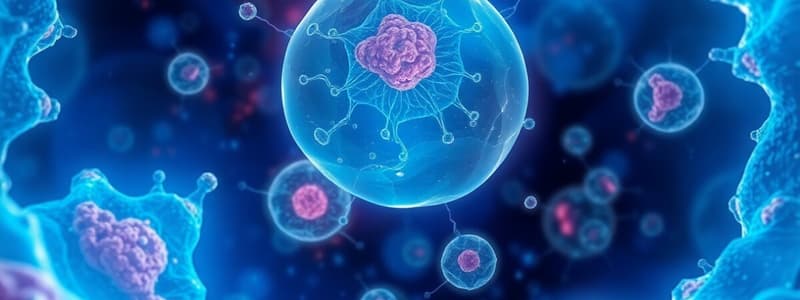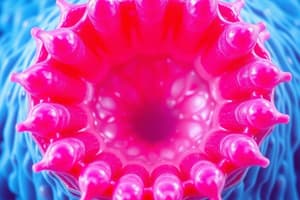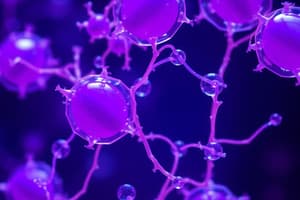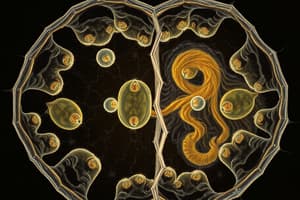Podcast
Questions and Answers
Which of the following structures is present in animal cells but not in plant cells?
Which of the following structures is present in animal cells but not in plant cells?
- Centrioles (correct)
- Golgi apparatus
- Chloroplasts
- Ribosomes
What is the main function of the rough endoplasmic reticulum?
What is the main function of the rough endoplasmic reticulum?
- Lipid synthesis
- Energy production
- Protein synthesis (correct)
- DNA replication
Which of the following options correctly identifies the components of the cytoskeleton?
Which of the following options correctly identifies the components of the cytoskeleton?
- Microfilaments and microtubules (correct)
- Lysosomes and peroxisomes
- Centrioles and mitochondria
- Nucleus and nucleolus
What is the primary function of lysosomes?
What is the primary function of lysosomes?
Which component is responsible for the synthesis of lipids?
Which component is responsible for the synthesis of lipids?
What is the basic structural and functional unit of every organism?
What is the basic structural and functional unit of every organism?
Which technique can be used for the isolation of subcellular structures?
Which technique can be used for the isolation of subcellular structures?
What type of microscope uses visible light to magnify cellular structures?
What type of microscope uses visible light to magnify cellular structures?
Which of the following statements about cells is true?
Which of the following statements about cells is true?
What is the maximum magnification capability of a light microscope?
What is the maximum magnification capability of a light microscope?
What size range are most plant and animal cells typically found in?
What size range are most plant and animal cells typically found in?
Which microscope is used to visualize smaller structures such as viruses?
Which microscope is used to visualize smaller structures such as viruses?
Which of the following is NOT a characteristic of cells?
Which of the following is NOT a characteristic of cells?
What type of images does a scanning electron microscope (SEM) provide?
What type of images does a scanning electron microscope (SEM) provide?
Which of the following statements about cilia is accurate?
Which of the following statements about cilia is accurate?
What is the primary advantage of electron microscopes over light microscopes?
What is the primary advantage of electron microscopes over light microscopes?
What method is primarily used in cell fractionation to separate cellular components?
What method is primarily used in cell fractionation to separate cellular components?
What is the resolution capability of a light microscope?
What is the resolution capability of a light microscope?
Which term describes the process of isolating cell organelles for analysis?
Which term describes the process of isolating cell organelles for analysis?
How are organelles separated during the process of cell fractionation?
How are organelles separated during the process of cell fractionation?
Which of the following is NOT a benefit of using electron microscopy?
Which of the following is NOT a benefit of using electron microscopy?
What is the function of pili in prokaryotic cells?
What is the function of pili in prokaryotic cells?
Where is the genetic material located in a prokaryotic cell?
Where is the genetic material located in a prokaryotic cell?
What are ribosomes primarily made of?
What are ribosomes primarily made of?
What is the primary role of ribosomes in prokaryotic cells?
What is the primary role of ribosomes in prokaryotic cells?
Which structure serves as the outer layer of a prokaryotic cell?
Which structure serves as the outer layer of a prokaryotic cell?
Where are ribosomes assembled within the cell?
Where are ribosomes assembled within the cell?
What is the function of ribosomes in the cell?
What is the function of ribosomes in the cell?
What is a characteristic feature of prokaryotic cells compared to eukaryotic cells?
What is a characteristic feature of prokaryotic cells compared to eukaryotic cells?
Which organelle is responsible for locomotion in some prokaryotic cells?
Which organelle is responsible for locomotion in some prokaryotic cells?
What type of proteins do free ribosomes primarily synthesize?
What type of proteins do free ribosomes primarily synthesize?
What structure outside the plasma membrane provides support to prokaryotic cells?
What structure outside the plasma membrane provides support to prokaryotic cells?
Which of the following correctly describes bound ribosomes?
Which of the following correctly describes bound ribosomes?
In prokaryotic cells, what is the main function of the plasma membrane?
In prokaryotic cells, what is the main function of the plasma membrane?
What structure regulates the entry and exit of molecules from the nucleus?
What structure regulates the entry and exit of molecules from the nucleus?
Which of the following statements about ribosomes is incorrect?
Which of the following statements about ribosomes is incorrect?
What is the size of a ribosome approximately?
What is the size of a ribosome approximately?
What is the primary feature of differential-interference-contrast microscopy?
What is the primary feature of differential-interference-contrast microscopy?
What is the major advantage of confocal microscopy over standard fluorescence microscopy?
What is the major advantage of confocal microscopy over standard fluorescence microscopy?
What is the maximum resolution of light microscopes as stated?
What is the maximum resolution of light microscopes as stated?
What limitation do most light microscopes have regarding subcellular structures?
What limitation do most light microscopes have regarding subcellular structures?
What is the function of the fluorescent dyes used in fluorescence microscopy?
What is the function of the fluorescent dyes used in fluorescence microscopy?
What type of imaging can be reconstructed using confocal microscopy?
What type of imaging can be reconstructed using confocal microscopy?
Which of the following best describes the limitation of light magnification?
Which of the following best describes the limitation of light magnification?
What is the primary purpose of using optical modifications in phase-contrast microscopy?
What is the primary purpose of using optical modifications in phase-contrast microscopy?
Flashcards
What is a cell?
What is a cell?
The fundamental unit of life, responsible for all biological functions within an organism.
What is cell biology?
What is cell biology?
The study of cells and their structures, using various tools like microscopes and biochemical techniques.
What is a light microscope (LM)?
What is a light microscope (LM)?
A type of microscope that utilizes visible light to magnify and illuminate a specimen. It's commonly used for observing the basic structures of cells.
What is an electron microscope (EM)?
What is an electron microscope (EM)?
Signup and view all the flashcards
What is cell fractionation?
What is cell fractionation?
Signup and view all the flashcards
How are all cells related?
How are all cells related?
Signup and view all the flashcards
Why is the study of cells important?
Why is the study of cells important?
Signup and view all the flashcards
How is cell structure related to cell function?
How is cell structure related to cell function?
Signup and view all the flashcards
Scanning Electron Microscope (SEM)
Scanning Electron Microscope (SEM)
Signup and view all the flashcards
Resolution
Resolution
Signup and view all the flashcards
Cell Fractionation
Cell Fractionation
Signup and view all the flashcards
Centrifuge
Centrifuge
Signup and view all the flashcards
Transmission Electron Microscope (TEM)
Transmission Electron Microscope (TEM)
Signup and view all the flashcards
Resolving Power
Resolving Power
Signup and view all the flashcards
Magnification
Magnification
Signup and view all the flashcards
Microscopy
Microscopy
Signup and view all the flashcards
What is Differential-interference-contrast (DIC) microscopy?
What is Differential-interference-contrast (DIC) microscopy?
Signup and view all the flashcards
What is fluorescence microscopy?
What is fluorescence microscopy?
Signup and view all the flashcards
What is Confocal microscopy?
What is Confocal microscopy?
Signup and view all the flashcards
What is the limitation of a light microscope (LM) in terms of resolution?
What is the limitation of a light microscope (LM) in terms of resolution?
Signup and view all the flashcards
How does one enhance contrast in light microscopy?
How does one enhance contrast in light microscopy?
Signup and view all the flashcards
What structures are too small to be resolved by a light microscope (LM)?
What structures are too small to be resolved by a light microscope (LM)?
Signup and view all the flashcards
What is the advantage of using an electron microscope (EM) over a light microscope (LM)?
What is the advantage of using an electron microscope (EM) over a light microscope (LM)?
Signup and view all the flashcards
What does cell fractionation aim to do?
What does cell fractionation aim to do?
Signup and view all the flashcards
What is a nucleoid?
What is a nucleoid?
Signup and view all the flashcards
What are ribosomes?
What are ribosomes?
Signup and view all the flashcards
What is a capsule?
What is a capsule?
Signup and view all the flashcards
What are pili?
What are pili?
Signup and view all the flashcards
What are flagella?
What are flagella?
Signup and view all the flashcards
What is a cell wall?
What is a cell wall?
Signup and view all the flashcards
What is the plasma membrane?
What is the plasma membrane?
Signup and view all the flashcards
What is cytoplasm?
What is cytoplasm?
Signup and view all the flashcards
Endoplasmic Reticulum (ER)
Endoplasmic Reticulum (ER)
Signup and view all the flashcards
Nuclear Envelope
Nuclear Envelope
Signup and view all the flashcards
Nucleolus
Nucleolus
Signup and view all the flashcards
Nucleus
Nucleus
Signup and view all the flashcards
Plasma Membrane
Plasma Membrane
Signup and view all the flashcards
What is the nuclear envelope?
What is the nuclear envelope?
Signup and view all the flashcards
What are pore complexes?
What are pore complexes?
Signup and view all the flashcards
What are free ribosomes?
What are free ribosomes?
Signup and view all the flashcards
What are bound ribosomes?
What are bound ribosomes?
Signup and view all the flashcards
What is the endoplasmic reticulum (ER)?
What is the endoplasmic reticulum (ER)?
Signup and view all the flashcards
What is the nucleolus?
What is the nucleolus?
Signup and view all the flashcards
What is ribosomal RNA?
What is ribosomal RNA?
Signup and view all the flashcards
Study Notes
Cell Structure and Function
- Cells are the basic structural and functional units of all organisms
- All organisms are made of cells
- Cell structure is related to cellular function
- Cells are related by descent from earlier cells
- Techniques for studying cells include microscopy and cell fractionation
- Microscopy is used to visualize cells and structures
- Light microscopy uses visible light.
- Electron microscopy uses beams of electrons
- Transmission electron microscopy (TEM) studies internal structures.
- Scanning electron microscopy (SEM) studies surface structures.
- Magnification and resolution are important aspects of microscopy.
- High resolution allows viewing of smaller details.
- Magnification is the ratio of image size to real size.
- Resolution is the minimum distance of two distinguishable points.
- Contrast is the visible differences in parts of a sample.
- Different types of microscopy methods are used for different purposes, including brightfield, phase-contrast, differential-interference-contrast, and fluorescence.
- Confocal microscopy creates 3D images by focusing laser light.
- Cell fractionation isolates subcellular components to determine their functions
- Separation is based on size and density.
- Centrifugation is used to fractionate cells into their component parts.
Cell Types and Structure
- Two types of cells: prokaryotic and eukaryotic.
- Prokaryotic cells (Bacteria and Archaea) are unicellular organisms.
- Features of prokaryotic cells: lack a nucleus, lack membrane-bound organelles, and have a nucleoid region for DNA.
- Eukaryotic cells (Protists, Fungi, Plants, and Animals) are larger and more complex with a nucleus and membrane-bound organelles.
- Examples of unicellular eukaryotic organisms are protists.
- Fungi can be unicellular or multicellular.
- Plants and animals are multicellular organisms.
- The first cells were prokaryotic. Eukaryotic cells developed later.
Comparison of Prokaryotic and Eukaryotic Cells
- Prokaryotic cells: do not have a nucleus or membrane-bound organelles; have one chromosome.
- Eukaryotic cells: have a nucleus, contain many membrane-bound organelles, and have many chromosomes.
Cellular Organelles
- Organelles are the specialized compartments within a cell.
Nucleus
- The nucleus is the genetic control center of the cell.
- Contains DNA, the genetic material of the cell
- DNA is organized into chromosomes within the nucleus.
- Regions of the nucleus include the Nucleolus where rRNA is made and the Nuclear Envelope which encloses the nucleus and regulates the passage of materials.
Ribosomes
- Ribosomes are the protein synthesis machinery of the cell.
- Made of rRNA and protein.
- Free ribosomes synthesize cytosolic proteins.
- Bound ribosomes synthesize secreted or membrane proteins.
Endoplasmic Reticulum (ER)
- The ER is a network of membranes.
- Two types: rough ER (RER) and smooth ER (SER).
- RER has ribosomes attached to its membrane, synthesizes and modifies proteins for secretion and insertion into the membrane.
- SER lacks ribosomes, synthesizes lipids, metabolizes carbohydrates, stores calcium, and detoxifies poisons.
Golgi Apparatus
- Modifies proteins and lipids received from the ER and sorts them for transport to other locations.
- Receives proteins and lipids from the ER.
- Modifies these products.
- Sorts and packages the modified products into vesicles.
Lysosomes
- Contain hydrolytic enzymes for intracellular digestion.
- Break down waste and worn-out cell parts.
- Functions include phagocytosis (consuming microorganisms) and autophagy (consuming damaged organelles).
Vacuoles
- Membrane-bound sacs with diverse functions.
- Plant cells typically contain one large central vacuole for storage, water balance, and maintaining cell turgor pressure.
- Food vacuoles are formed by phagocytosis used for digestion.
Mitochondria
- Site of cellular respiration.
- Chemical energy conversion - converts chemical energy from glucose to ATP (usable chemical energy).
- Found in nearly all eukaryotic cells.
- Composed of two membranes: outer membrane and inner membrane with cristae.
Chloroplasts
- Site of photosynthesis in plants and algae.
- Contain chlorophyll, which captures light energy.
- Converts light energy to chemical energy to make sugars.
- Double membrane - an outer membrane and an inner membrane with thylakoids stacked into grana.
Peroxisomes
- Specialized metabolic compartments.
- Produce hydrogen peroxide and convert it to water.
- Involved in detoxification.
- Involved in fatty acid breakdown.
Proteasomes
- Degrade short-lived or damaged proteins.
- Target proteins for degradation using ubiquitin.
Cytoskeleton
- A network of protein fibers throughout the cytoplasm.
- Maintains cell shape and plays a role in cell movement and support of internal components.
- Microfilaments, intermediate filaments and microtubules are part of the cytoskeleton and have different roles.
Studying That Suits You
Use AI to generate personalized quizzes and flashcards to suit your learning preferences.




